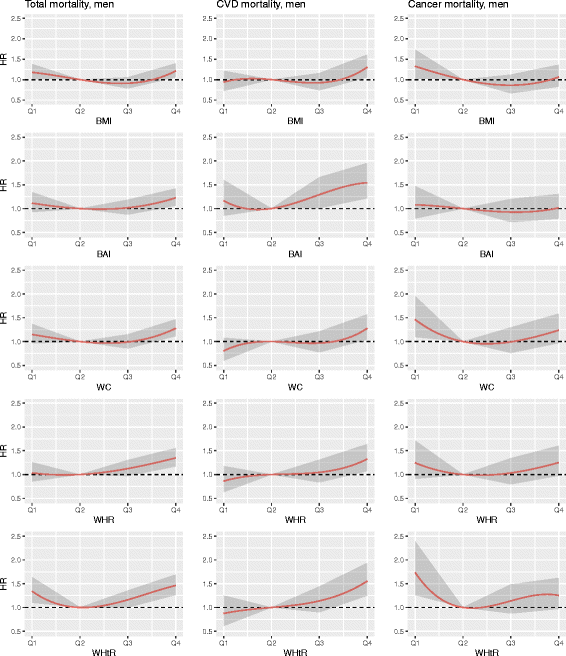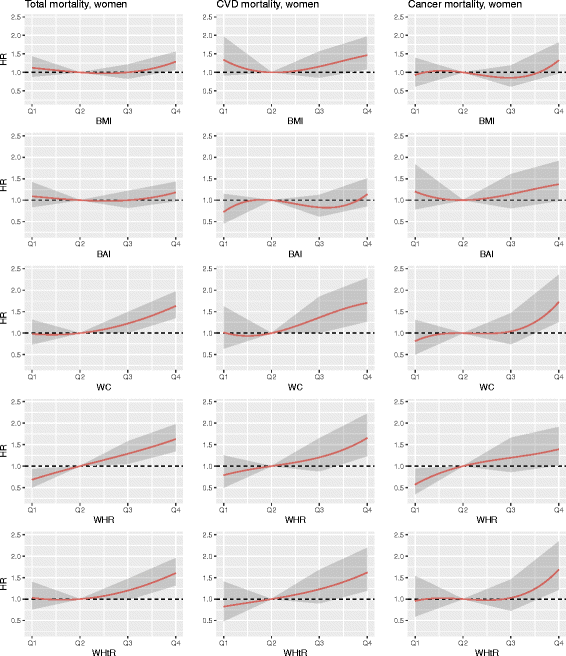New indexes of body fat distribution and sex-specific risk of total and cause-specific mortality: a prospective cohort study
- PMID: 29609587
- PMCID: PMC5879745
- DOI: 10.1186/s12889-018-5350-8
New indexes of body fat distribution and sex-specific risk of total and cause-specific mortality: a prospective cohort study
Abstract
Background: A number of prior studies have examined the association between anthropometric measures and mortality, but studies investigating the sex-specific predictive value of novel anthropometric measures on mortality are scarce so far. Therefore, we investigated the sex-specific relevance of the new anthropometric measures body adiposity index (BAI) and waist to height ratio (WHtR) as well as the common measures body mass index (BMI), waist circumference (WC), and waist to hip ratio (WHR) for cause-specific mortality risk.
Methods: The analysis was based on data from the German population based KORA (Cooperative Health Research in the Region of Augsburg) Augsburg cohort study. A total of 6670 men and 6637 women aged 25 to 74 years at baseline examination were included. During a mean follow-up period of 15.4 years, 2409 persons died. Via Cox proportional hazard regression, the associations between the different anthropometric measures and all cause-, cardiovascular disease (CVD)- and cancer mortality were assessed.
Results: BMI, WC, and WHR were significantly associated with all-cause and CVD-mortality in both sexes. WC and WHR were particularly associated with higher all-cause and CVD-mortality risk in women, while in men especially WHtR and BAI were strongly related to these outcomes. Females with WC, WHtR, and WHR measures in the 4th quartile compared with women in the 2nd quartile had a higher risk of death from cancer. Contrary, men in the lowest quartile of WC and WHtR in comparison to men in the 2nd quartile had a significantly elevated cancer mortality risk. BAI was no risk predictor for all-cause and cause-specific mortality in women.
Conclusions: Central obesity reflects higher all-cause and CVD-mortality risk particularly in women. BAI and WHtR seem to be valid as risk predictors for all-cause and especially CVD mortality in men but not women. There are marked sex-differences regarding cancer mortality risk for the different anthropometric measures.
Keywords: All-cause mortality; Anthropometric measures; Body adiposity index; Cancer mortality; Cardiovascular mortality; KORA; Obesity; Prospective study.
Conflict of interest statement
Ethics approval and consent to participate
The study was approved by the ethics committee of the Bavarian Medical Association (“Bayerische Landesärztekammer”) and performed in accordance with the Declaration of Helsinki. All individuals whose data were included in the analyses gave their written informed consent to participate in the study.
Consent for publication
Not applicable
Competing interests
The authors declare that they have no competing interests.
Publisher’s Note
Springer Nature remains neutral with regard to jurisdictional claims in published maps and institutional affiliations.
Figures
References
-
- National Heart, Lung, and Blood Institute . Management of Overweight and Obesity in adults: guidelines from the expert panel. 2013.
Publication types
MeSH terms
LinkOut - more resources
Full Text Sources
Other Literature Sources



